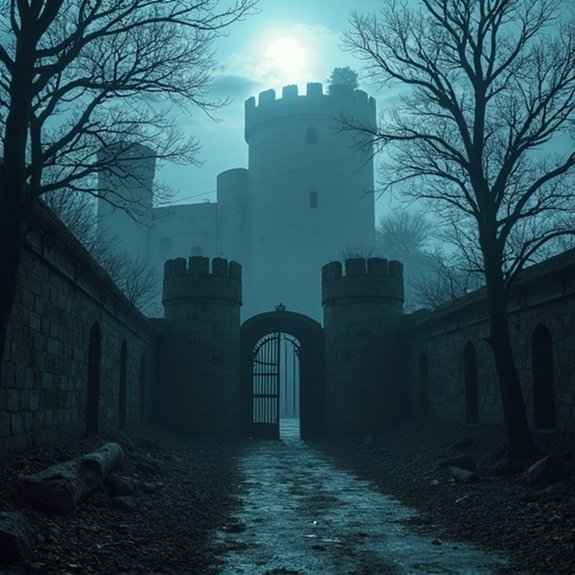Haunted Ruins: Abandoned Fortresses
Stone walls that once repelled invaders now harbor something far more unsettling. Abandoned fortresses across the globe aren’t just crumbling monuments to ancient warfare—they’ve become epicenters of unexplained phenomena. Investigators document spectral apparitions in empty battlements, electromagnetic spikes in dungeons, and voices echoing through halls where no living person stands. What transforms these military strongholds into paranormal hotspots remains one of archaeology’s most compelling mysteries.
Introduction

When shadows lengthen across crumbling stone walls and wind whistles through empty doorways, abandoned structures take on an otherworldly presence that’s captivated humanity for centuries. These forsaken fortresses stand as monuments to forgotten conflicts and lost civilizations. Their decaying ramparts and collapsed towers tell stories of battles, betrayals, and mysterious disappearances that’ve spawned countless legends.
From medieval castles in Europe’s remote valleys to ancient citadels perched on Asian mountaintops, these ruins attract paranormal investigators, historians, and thrill-seekers alike. They’re drawn by reports of ghostly apparitions, unexplained sounds, and the palpable sense of dread that permeates these sites. Whether one believes in supernatural phenomena or not, there’s no denying the powerful atmosphere these abandoned strongholds create through their isolation, deterioration, and tragic histories.
Ancient Warfare’s Architectural Legacy
The strategic demands of ancient warfare shaped these fortifications in ways that still haunt their ruins today. Ancient engineers designed kill zones where defenders could rain arrows on exposed attackers. They carved narrow passages that forced invaders into single-file columns, making them vulnerable to boiling oil from murder holes above. These architects built towers at precise angles to eliminate blind spots and maximize crossfire coverage.
Every architectural element served warfare’s brutal calculus. Walls curved outward to deflect catapult stones. Gates featured multiple portcullises to trap enemies between iron grilles. Spiral staircases wound clockwise, giving right-handed defenders the advantage while hindering ascending attackers’ sword arms. Even today, visitors can’t escape the oppressive atmosphere these designs created—spaces engineered for violence that echo with tactical paranoia.
Notable Cases or Sightings

Since the 1970s, paranormal investigators have documented hundreds of encounters at Europe’s most notorious castle ruins. They’ve recorded unexplained voices at Germany’s Heidelberg Castle, where visitors report seeing a woman in white walking the ramparts. Scotland’s Edinburgh Castle attracts researchers who’ve captured electromagnetic anomalies near the dungeons where prisoners died centuries ago.
France’s Château de Châteaubriant stands out for its reported spectral activity. Guards claim they’ve witnessed shadow figures in the tower where Françoise de Foix allegedly died in 1537. Eastern Europe’s fortresses generate similar reports. Romania’s Poenari Castle, Vlad the Impaler’s stronghold, produces consistent accounts of screams echoing from empty chambers. Modern equipment has detected temperature drops and audio frequencies that investigators can’t explain through conventional means.
Common Theories or Explanations
Although skeptics attribute most haunted ruin phenomena to natural causes, researchers have developed several competing theories to explain persistent paranormal reports. Environmental factors theory suggests that underground water, electromagnetic fields, and infrasound from wind passing through damaged structures create sensory disturbances that witnesses interpret as supernatural encounters.
The stone tape hypothesis proposes that limestone and quartz in fortress walls can record traumatic events and replay them under specific conditions. Meanwhile, psychologists argue that expectation bias and the ruins’ intimidating atmosphere trigger hallucinations and false memories.
Paranormal investigators claim that violent deaths at these sites create residual energy or attract spirits unable to move on. They’ve documented temperature anomalies, electromagnetic spikes, and unexplained recordings that don’t match conventional explanations, though mainstream science hasn’t validated these findings.
Frequently Asked Questions
Can I Legally Explore Abandoned Fortresses on My Own?
One can’t legally explore abandoned fortresses without permission from the property owner or relevant authorities. They’ll need to research ownership, obtain permits, and check local trespassing laws before entering any abandoned structures for safety.
What Safety Equipment Should I Bring When Visiting These Ruins?
Explorers should bring sturdy boots, flashlights with backup batteries, first aid kits, hard hats, work gloves, and rope. They’ll need dust masks for air quality, water, emergency whistles, and fully charged phones for unexpected situations.
Are Guided Tours Available at Any Haunted Fortress Locations?
Yes, several haunted fortresses offer guided tours. Edinburgh Castle’s ghost tours run nightly, while Eastern State Penitentiary provides daytime and special Halloween experiences. Visitors’ll find most European castles feature professional guides who share paranormal histories.
What’s the Best Time of Year to Visit Abandoned Fortresses?
Spring and autumn offer ideal visiting conditions for abandoned fortresses. Visitors’ll find mild temperatures, fewer crowds, and better photography lighting. October’s particularly popular for haunted locations, while May provides comfortable exploration weather without summer’s intense heat.
How Much Does It Typically Cost to Access These Sites?
Most abandoned fortresses don’t charge admission since they’re unmanaged ruins. However, guided tours typically cost $10-30 per person. Some restored sites charge $5-15 entry fees. Visitors should budget for parking and potentially hiring local guides.


